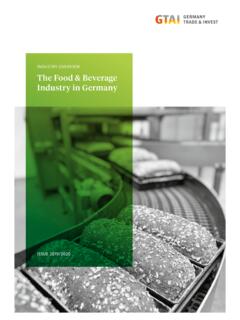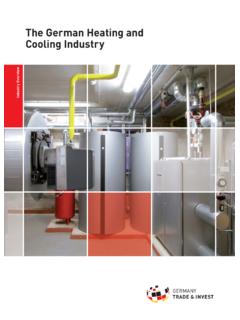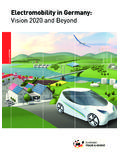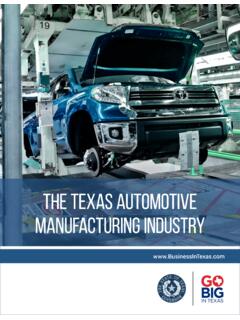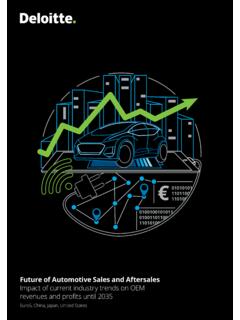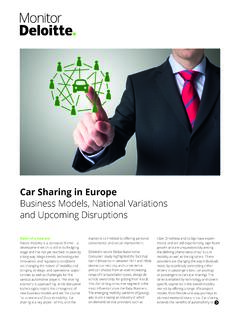Transcription of The Automotive Industry in Germany
1 Industry OVERVIEW The Automotive Industry in GermanyISSUE 2020/2021 Engineering and Production Excellence Germany is recognized the world over for its outstanding Automotive Industry and excellence in engineering. From Asia to the Americas, German cars embody highly cher-ished values of innovation, reliability, safety, and design. Germany is by some distance Europe s leading production and sales market. The country s world-class R&D infrastruc-ture, complete Industry value chain integration, and highly qualified workforce create an internationally peerless auto- motive environment. It enables companies to develop cutting- edge technologies which perfectly address tomorrow s mobility needs. Combating the Covid-19 Crisis The country has moved swiftly to counteract the worst effects of the global Covid-19 crisis, implementing a far-reaching financial support package for the Industry .
2 These include an effective doubling of cash incentives for electric vehicle purchases and significant investment in charging infrastructure as part of a broader EUR 130 billion economic stimulus package to jump-start the German economy. THE Automotive Industry IN Germany The Automotive sector is the backbone Industry in Germany , and the German Automotive Industry is a global leader. Germany is also one of the strongest countries in the world when it comes to high-tech Automotive products, including autonomous driving technology. Hui Zhang Managing Director, NIO Germany GmbH24%of total domestic Industry revenue generated by Automotive Industry 75%of cars manufactured in Germany in 2019 destined for export markets +60%R&D growth in Europe created by German Automotive sector1/3of global Automotive R&D spending made by German OEMs 1 in 5cars that roll of the international production line is German OEM made The World s Automotive Innovation millionpassenger vehicles produced in 2019 making Germany Europe's leading production sitePassenger car production in Europe 2019 in million unitsSources.
3 VDA, ACEA 2020It l Slov U Czech Fr nceSp nGerm n 2 31 61 41 31 10 54 6 Pol ndBel umSp nIt l Fr nceU Germ n 3 62 32 21 91 30 60 63 Germany s Industry numbers speak for them-selves and for a secure and successful invest-ment in the country. Europe s Biggest Automotive Market Germany is Europe s number one Automotive market in production and sales terms; account-ing for around 25 percent of all passenger cars manufactured and almost 20 percent of all new registrations. Germany also boasts the largest concentration of OEM plants in Europe. There are currently 43 OEM sites located in Germany . German OEM market share in the EU was more than 55 percent in 2019. Manufacturing Leader Germany German automobile manufacturers produced over 16 million vehicles in 2019. Eighteen of the world s 100 top Automotive suppliers are German com-panies.
4 Germany is the European car production leader: more than million passenger cars and 283,567 commercial vehicles were manufactured in German plants in 2019. Export Success German passenger car and light commercial vehicle OEM generated foreign market revenue of almost EUR billion in 2019 a two percent increase over 2018. Automotive exports account for more than 13 percent of all German exports in 2019 the product group with the largest export share. Domestic market revenue is EUR bil-lion a two percent increase compared to 2018. R&D Leadership German OEMs are responsible for R&D invest-ments amounting to almost EUR billion in 2018. Germany s Automotive sector is the coun-try s most innovative Industry sector, accounting for 35 percent of total German Industry R&D expenditure of around EUR 72 billion in 2018.
5 Research and development personnel within the German automobile Industry reached a level of 126,400. Passenger car registrations in Europe 2019 in million unitsSource: 2020833,000 Workforce945 OEMs and SuppliersEUR bnIndustry TurnoverEUR bnExport TurnoverGermany s Automotive Industry in Numbers4 Industry Overview 2020/21 | Market PerspectivePremium Market HubGermany is the world s premium car production hub. Of all premium branded vehicles produced globally, 67 percent are German OEM-manufac-tured. Of all vehicles produced globally, 53 percent of vehicles were produced in Europe (36 percent were made in Germany in 2019). Within Europe, more than 80 percent are German OEM-badged vehicles 67 percent of these vehicles were made in Germany . The western European light vehicle production sector is predominantly premium sector focused.
6 As a result, the scale and range of production is expanding significantly. Production of premium segment cars will continue to grow (currently 38 percent share of western European light vehicle production).Growing Premium MarketGlobally, the premium market segment will grow at a much faster rate than the total passenger car segment in the next decades. Growth can be mainly attributed to growing international demand for high-value, premium small- and compact-sized cars as well as premium SUVs. The German Automotive Industry is the leading producer of premium cars worldwide. Almost all German and Germany -based manufacturers have already launched or intend to launch new products meeting premium segment demand. The know-how based on the country s Automotive manufacturing tradition will further strengthen Germany as a leading international Automotive manufacturing R&D InvestmentGerman Automotive company investment in research and development remains strong as manufacturers seek to maintain the competitive-ness of vehicles Made in Germany .
7 In 2018, German Automotive companies spent almost EUR billion on internal R&D projects; more than any other domestic manufacturing sector. More than one third of Germany s total manufacturing Industry R&D expenditure is spent by automo-tive manufacturers and suppliers, with R&D budgets expected to rise. Germany s Automotive companies employ the largest number of research personnel in the manufacturing sector. With 126,400 researchers (full-time equivalent), auto-motive companies employ more than one quarter of the total R&D workforce in Germany s private Production LocationGerman cars continue to enjoy a globally positive image and are in high demand across the world. A recent Ernst & Young study of 300 companies active in the European Automotive sector (15 percent OEMs and 85 percent suppliers) finds Ger-many to be the most innovative Automotive hub in international comparison.
8 Eighty-one percent of those companies surveyed consider Germany to be the most competitive hub in terms of innova-tive power ahead of Japan and South Korea who polled 65 percent and 61 percent OPPORTUNITIESG erman autos remain in great demand interna-tionally particu-larly in the premium market sectorPremium Car Production by Country 2019in percentLight Vehicle Production Trendproduction volume as share of worldwide productionSource: GTAI 2018 (analysis based on data derived from MarkLines database) Germany France Asia USA (incl. Opel) Other EuropeSource: Statista 201837 Germ n Rest of the WorldCh n USAU J p n201614662019201220052833121972047151452 045151555 Technological TrendsSustainable MobilityAutomotive engineers in Germany are hard at work improving internal combustion engine energy efficiency, developing alternative drive technologies (including electric, hybrid, and fuel cell cars), and adapting lightweight materials and electronics.
9 Carbon emission reduction targets, smart traffic management, and the government s electric mobility initiative are major drivers for future mobility growth. According to McKinsey, the overall market value for new vehicles with optimized combustion engines is set to reach between EUR 280 billion and EUR 330 billion by 2020. Impressive developments have already been made in developing smaller, highly charged-up homogeneous combustion engines and dual clutch transmissions (DCTs). Overall market potential for efficient drive systems is valued at between EUR 325 billion and EUR 500 billion through to and international market potential for energy-efficient passenger cars is huge. The global market is expected to grow by almost 30 percent in 2020. Supported by the country s ambitious e-mobility plans, the Automotive sector has set itself the goal of becoming a lead provider and market of electromobility solutions in 2020.
10 The country also has ambitious e-mobility plans out- side Germany , with German OEMs keen to meet rising export demand for vehicles in the USA and emerging economies. Economic growth, the changing mobility requirements of a young and aspirational population, and the relatively low density of passenger cars are driving demand in the emerging economies. This will allow manufac-turers located in Germany to successfully follow their proven strategy of increased imports and on-site ConnectivityThe demand for connected cars is set to increase significantly, nowhere more so than in the pre-mium segment. Facilitating a raft of innovative safety, comfort and information services, smart technologies are revolutionizing the driving experi-ence. According to Mordor Intelligence, car connec-tivity is the fastest-growing feature being adopted into new vehicles, with the connectivity market forecast to generate up to USD 1 trillion by the end of 2030.
